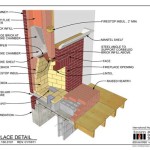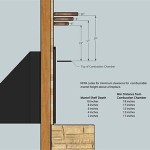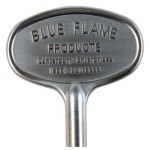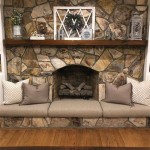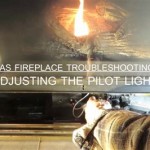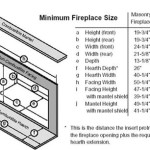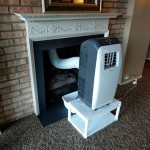Tv Over Fireplace Cable Box Considerations
Mounting a television above a fireplace has become a popular interior design choice. This arrangement offers space-saving benefits and consolidates entertainment around a central focal point. However, integrating a cable box and other associated components into this setup presents specific challenges that require careful consideration. This article explores the key aspects of managing a cable box in a television-over-fireplace installation, focusing on heat concerns, signal transmission, remote control functionality, and aesthetic integration.
Heat Management and Cable Box Longevity
One of the primary concerns when placing electronic equipment, such as a cable box, above a fireplace is the potential for heat damage. Fireplaces, whether gas or wood-burning, generate significant heat that can rise and accumulate near the ceiling. Exposing a cable box to prolonged periods of high temperatures can lead to reduced performance, component failure, and a shortened lifespan. Cable boxes are designed to operate within a specific temperature range, and exceeding these limits can compromise their internal circuitry.
Proper ventilation is crucial for mitigating heat-related risks. When planning a television-over-fireplace setup, consider the fireplace's heat output and the cable box's tolerance. Ideally, the cable box should be placed away from the direct path of rising heat. Options include installing the cable box in a separate cabinet or media console located to the side of the fireplace or within a purpose-built recess in the wall. If these options are not feasible, consider using heat shields or deflectors to redirect heat away from the cable box. Another alternative is to explore a cooling fan system designed to circulate air around the cable box and prevent overheating.
Regular monitoring of the cable box's temperature can also help identify potential problems early. Some cable boxes have built-in temperature sensors that can be accessed through the device's settings. If such a feature is unavailable, an external thermometer can be used to measure the temperature around the cable box. If the temperature consistently exceeds acceptable levels, immediate action should be taken to improve ventilation or relocate the device.
Signal Transmission and Connectivity Solutions
Cable boxes require a reliable connection to the cable provider's network and to the television. In a television-over-fireplace setup, this often involves running cables through walls, which can be complex and require professional installation. The distance between the cable box and the television, as well as the placement of the cable outlet, must be carefully considered to ensure optimal signal strength and picture quality.
High-quality coaxial cables and HDMI cables are essential for transmitting signals without degradation. Coaxial cables connect the cable box to the incoming cable signal, while HDMI cables connect the cable box to the television, providing audio and video output. When running cables through walls, it is generally advisable to use in-wall rated cables, which are designed to meet fire safety standards and prevent the spread of flames. These cables typically have a higher fire-resistance rating than standard cables. It is also vital to use appropriate cable management techniques, such as cable ties and wall plates, to keep cables organized and prevent damage.
In some cases, it may be necessary to use signal boosters or amplifiers to maintain signal strength over longer cable runs. These devices amplify the signal, compensating for signal loss that can occur over distance. Wireless solutions, such as HDMI extenders, can also be used to transmit audio and video signals wirelessly between the cable box and the television. However, wireless solutions may be susceptible to interference and latency issues, which can affect picture and sound quality. Choosing a reliable and well-reviewed wireless HDMI extender is essential for a satisfactory outcome.
Remote Control Functionality and Accessibility
Controlling a cable box that is located away from the television requires careful consideration of remote control functionality. Standard infrared (IR) remote controls require a direct line of sight to the cable box, which may be obstructed when the cable box is hidden behind a wall or inside a cabinet. Radio frequency (RF) remote controls offer a solution to this problem, as they do not require line of sight and can transmit signals through walls and other obstacles. Many modern cable boxes are compatible with RF remote controls, or can be paired with an IR extender.
An IR extender consists of a small IR receiver that is placed near the television and an IR transmitter that is placed near the cable box. The IR receiver picks up the signals from the remote control and transmits them to the IR transmitter, which then relays the signals to the cable box. This effectively extends the range of the remote control and allows the cable box to be controlled even when it is not in direct line of sight. Some universal remotes also offer RF capabilities and can be programmed to control multiple devices, including the cable box and television.
Accessibility is another factor to consider. If the cable box is located in a difficult-to-reach location, it may be challenging to access it for maintenance or troubleshooting purposes. Ensuring easy access to the cable box for tasks such as resetting the device or changing cables is important. Strategically placing the cable box in a location that is both discreet and easily accessible balances aesthetic considerations with practical needs. Consider using a cabinet with a hinged door or a removable panel to provide easy access to the cable box while keeping it hidden from view.

How To Hide The Cable Box Tv Over Fireplace Cables

How To Hide The Cable Box Tv Cords Wires

How To Hide The Cable Box

How To Hide A Cable Box In 5 Easy Steps Home Like You Mean It

Where To Put Cable Box With Tv Over Fireplace For Stereo Dvd Player Game System And Flat Panel Wall Mounted Above

Tv Wall Mount Installation With Wire Concealment Over Fireplace

Tv Wall Mount Installation With Wire Concealment Over Fireplace

Lowkeyinstallations Com Tv Above Fireplace Family Room

How To Mount A Tv Over Brick Fireplace And Hide The Wires Designing Vibes Interior Design Diy Lifestyle

Tv Wall Mount Installation With Wire Concealment Over Fireplace
Related Posts

